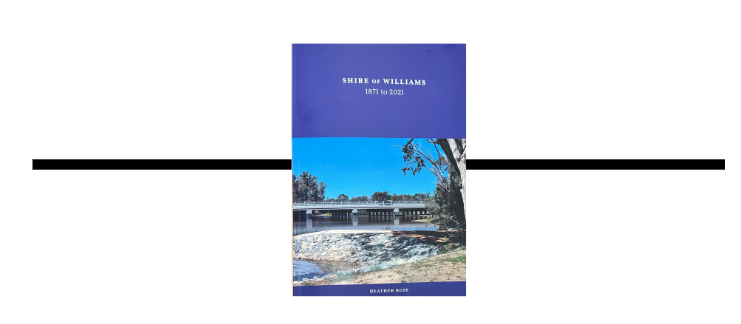Williams belongs to the Gnaala Karla Boodja region, referring to the Noongar language or dialectical groups of the BinJarab/Pinjarup, Wilman and Ganeang.
The Williams District was first explored in 1831, when Captain Thomas Bannister led the first overland expedition from the Swan River Colony to King George Sound (Albany). During this expedition, they discovered a River flowing through their route and named it “Williams River”, most likely the name honours King William lV, who reigned England from 1830-1837.
The first claims on and in the area occurred in 1832. In 1835, an expedition led by Governor James Stirling and John Septimus Roe surveyed a route joining King George Sound with York via Williams to encourage inland settlement.
The Albany Highway was first built by convicts in the 1850’s, with the tendering of a reliable mail service around 1853, the road was upgraded and Williams became an important stop over point for passengers and changing of horses. It subsequently developed as the District Centre for Local Government, which was granted in 1877.
The small town was subject to increasing floods due to the clearing of the land for intensive farming, therefore the town was relocated to the Perth side of the bridge. The town site was surveyed in 1905 and most of the buildings in the present town site were constructed after that time. Williams is still reliant on wool and coarse grains and caters for about 2,500 vehicles per day. The population has stabilised in the district to around 1,000 with about 400 in the town.

Heritage Trail Brochure
The Williams Heritage Trail was established in 1988 as a Bicentennial Project by the Williams Historical Society, Williams District High School and the Williams Shire Council. The trail explores early areas of settlement and has 2 section: a 1km walk along the main street of the Williams Township and a 35kn scenic drive to Quindanning. It includes an optional visit to the Tarwonga School Site and Inn, and provides a pleasant half-days outing with opportunities for picnicking.
For the complete brochure on the trail, click here.
The Williams by H.G Cowin
This is a simple story of the growth of the district usually referred to as The Williams. From a pioneer selection made many miles from the centre of the sparse settlement at Swan River, the district has grown depending almost solely on the soil and what man could make it produce.
Before the stories can be forgotten, 'The Williams' is a record of the pioneers written by a man who, with his family, can be numbered among the early settlers of this century.
Council has for sale copies of the book ‘The Williams’ by Hurtle G. Cowin, a history of the growth of the Williams District. These have recently been re-printed and are available now for $15.00 at the Council Office.

Shire of Williams 1871 - 2021 by Heather Rose
A glimpse at the developments which took place in the evolving history of the Shire of Williams from 1871-2021.
Heather has written smaller historical books and articles, however this book is a substantial piece written with the help of a number of local residents who have a keen interest in the history and development of Williams.
This book brings you into the lives of the people from our past, how they lived and what it was like being a part of earlier community development and daily life. The changes from the early Roads Board, whose focus was solely on roads, to today's very complex administration of local laws and provision of services and facilities, is quite different in many ways - as is our way of life in 2021.
Council has for sale copies of the book ' Shire of Williams 1871-2021' by Heather Rose, available for $40 at the Council Office.

Municipal Heritage Inventory
Council’s Municipal Heritage Inventory can be viewed at the Council Office Monday – Friday. It includes some 285 listings from the Williams area.